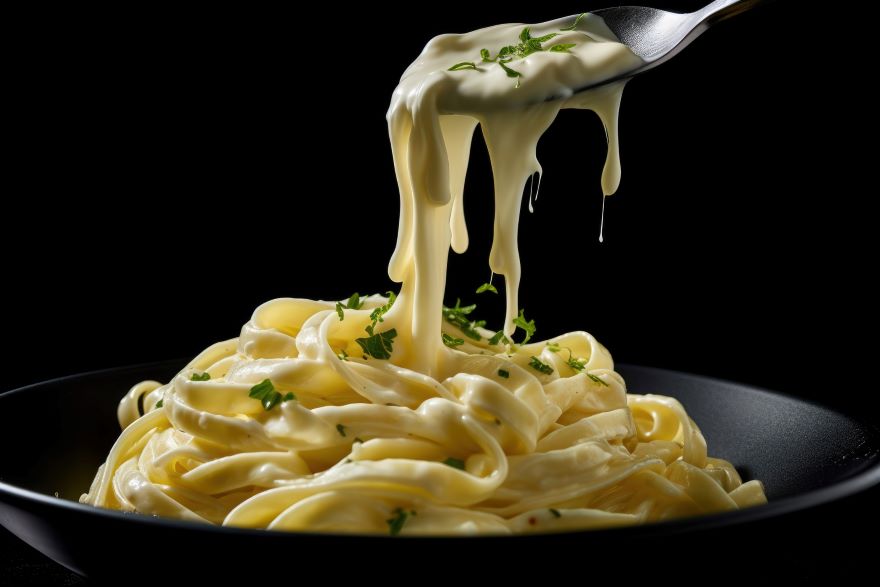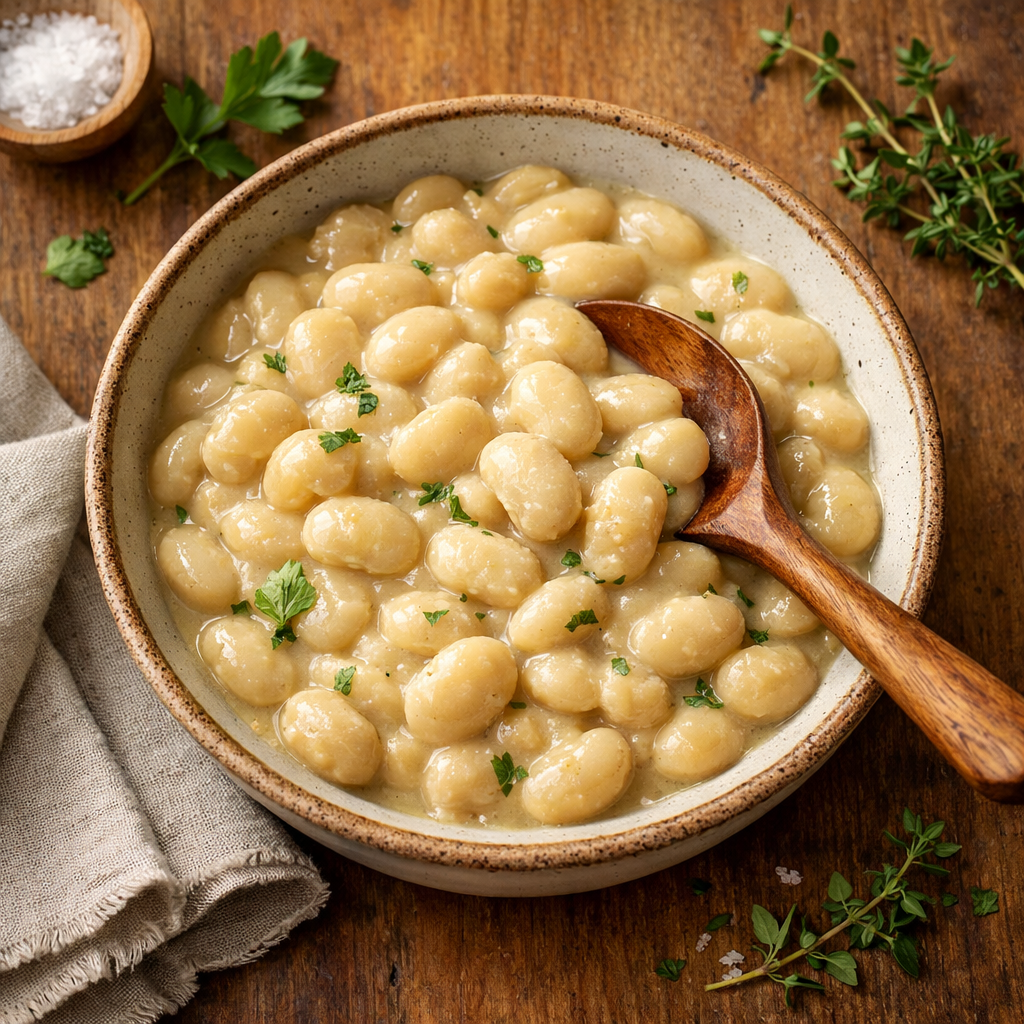I was scrolling through YouTube when I came across a video about dairy-free Alfredo sauce. Since I’ve always preferred tomato-based sauces, I didn’t think much of it and moved on.
A few days later, over dinner with James and Bruce, they started craving Alfredo pasta. I listened quietly as they reminisced, mentioning that it had been months since they’d had anything other than traditional tomato sauce with their pasta. Eventually, they convinced me to give it a try. Since Alfredo sauce isn’t usually my thing, I wanted to create something special—healthier, with a unique twist—so we could all enjoy it. It was my first attempt, and while I was excited, I definitely didn’t want it to be a disaster!
A New Perspective on Dairy-Free Alfredo
That dinner conversation made me realize there might be more to dairy-free Alfredo than I had initially thought. James had recently started exploring dairy alternatives, and Bruce was cutting back on dairy for health reasons. Their enthusiasm sparked my curiosity.
The next morning, I dove into research—reading blogs, watching tutorials, and even consulting a chef friend. I was amazed by the world of dairy-free cooking, a realm I had never truly explored before.
Why Go Dairy-Free?
During my research, I learned that about 65% of the global population has some level of lactose intolerance—a staggering number! It made me think about how many people miss out on their favorite dishes due to dietary restrictions.
People avoid dairy for various reasons:
- Health – Some reduce dairy to lower cholesterol or improve digestion.
- Environment – Dairy production has a significant environmental impact.
- Ethics – Many follow plant-based diets for animal welfare.
- Personal Preference – Some simply feel better without dairy.
With all this in mind, I was determined to create a dairy-free Alfredo sauce that wasn’t just a substitute but a delicious, creamy alternative that everyone would love.
The Science Behind Dairy-Free Alternatives
I’ve always been fascinated by the science of cooking—understanding not just how ingredients work but why they do. So when I set out to make a dairy-free Alfredo sauce, I wanted to dig deeper into the alternatives. What I discovered was both surprising and exciting.
The Magic of Plant-Based Milk
Each type of plant-based milk brings something unique to the table:
- Almond Milk: I learned that almonds are rich in vitamin E and healthy fats. When transformed into milk, they provide a light but creamy base that’s perfect for sauces. The subtle nutty flavor actually complements the other ingredients in Alfredo sauce beautifully.
- Coconut Milk: The high fat content in coconut milk makes it an excellent cream substitute. I discovered that the medium-chain triglycerides (MCTs) in coconut milk not only provide creaminess but also offer some interesting health benefits.
- Cashew Milk: This became my personal favorite for sauces. When blended, cashews create an incredibly smooth, rich base that’s almost indistinguishable from dairy cream. Plus, they’re packed with minerals like magnesium and zinc.
- Soy Milk: The high protein content in soy milk helps create a stable sauce that doesn’t separate when heated. It’s also the closest to dairy milk in terms of protein content.
- Oat Milk: I was surprised to learn that oat milk contains beta-glucans, which can help lower cholesterol levels. Its naturally sweet taste and creamy texture make it another excellent choice for sauces.
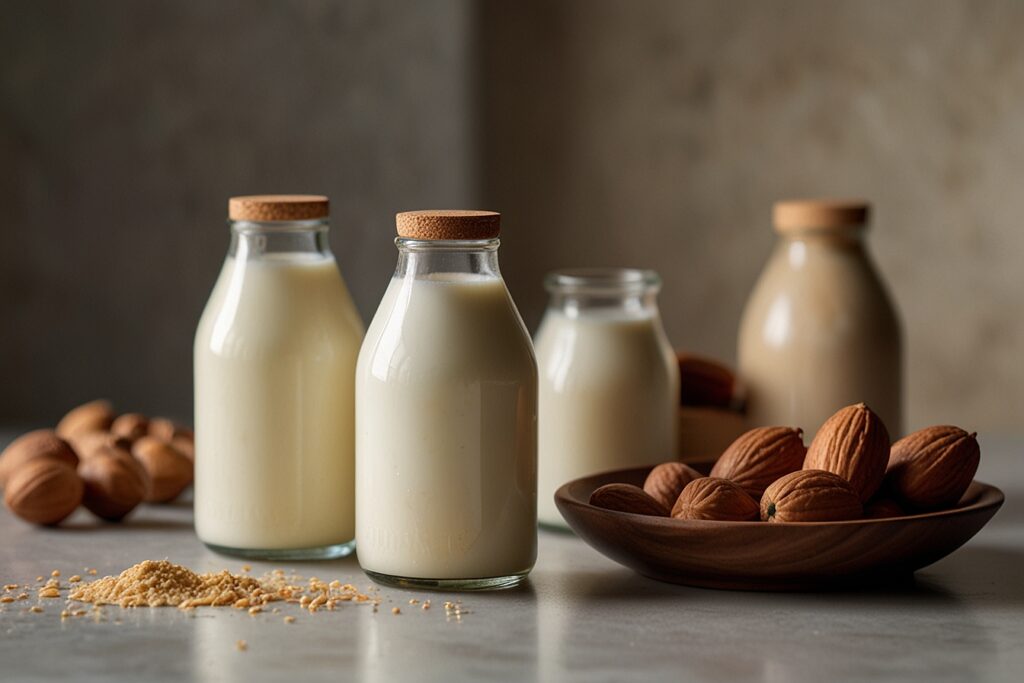
The Secret Weapon: Nutritional Yeast
One ingredient completely transformed my approach to dairy-free cooking: nutritional yeast. I still remember my first time using it—I opened the container and hesitated. The yellow flakes and strong aroma didn’t exactly scream delicious. But the moment I added it to my sauce, something magical happened. It delivered the rich, umami-packed, cheesy flavor I thought was impossible to achieve without dairy.
My Kitchen Workshop: Crafting the Perfect Recipe
The Evolution of My Recipe
My first attempts at dairy-free Alfredo sauce were… interesting, to say the least. But with each attempt, I refined the flavors and textures, turning trial and error into a delicious success. Here’s how my recipe evolved:
First attempt : The Basic Version
- Used only almond milk and flour
- Result: Too thin and lacking flavor
- Lesson learned: Need more substance and depth
Second attempt: The Nutty Experiment
- Added cashews for creaminess
- Result: Better texture but still missing somethingt
- Lesson learned: Texture is important but so is flavor
Final attempt: The Breakthrough
- Combined multiple elements
- Added nutritional yeast
- Incorporated cauliflower for extra creaminess
- Result: Getting closer!
- Lesson learned: Layering ingredients creates complexity
The Final Recipe That Won Everyone Over

After numerous attempts, here’s what I found works best:
Base Ingredients:
- Juice of half a lemon
- 1 cup raw cashews (soaked overnight)
- 2 cups plant-based milk (I use a combination of almond and cashew)
- 1/2 head cauliflower, steamed
- 4 cloves garlic (yes, I increased it!)
- 3 tablespoons nutritional yeast
- 1 tablespoon olive oil
- 2 tablespoons flour
- 1 teaspoon sea salt
- 1/2 teaspoon black pepper
- 1/4 teaspoon nutmeg (my secret ingredient)
- Juice of half a lemon
Mastering the Technique
The process of making this sauce has become almost therapeutic for me. Here’s my detailed approach:
Preparation Phase
- Soaking the Cashews
- I start this the night before
- Cover them with filtered water
- Add a pinch of salt
- Let them soak for at least 8 hours
- Preparing the Cauliflower
- Steam until very tender
- This usually takes about 10 minutes
- The softer it is, the creamier your sauce will be
The Cooking Process
- Starting the Base
- Heat olive oil in a large pan
- Add minced garlic
- Cook until golden but not brown
- This usually takes 2-3 minutes
- Creating the Roux
- Add flour to the garlic and oil
- Stir constantly for 1-2 minutes
- This prevents any lumps from forming
- The roux should smell slightly nutty
- Building the Sauce
- Slowly add the plant-based milk
- Whisk continuously
- Let it simmer and thicken
- This takes about 5-7 minutes
- The Blending Stage
- Combine in a high-speed blender:
- The milk mixture
- Soaked cashews
- Steamed cauliflower
- Nutritional yeast
- Seasonings
- Blend until silky smooth
- This might take 2-3 minutes
- Combine in a high-speed blender:
Achieving the perfect creamy consistency for your dairy-free Alfredo sauce requires a high-performance blender. The Vitamix 5200 Blender is renowned for its powerful motor and versatility, making it an excellent choice for blending smooth sauces, soups, and more. Its variable speed control and durable design ensure consistent results every time. Investing in this blender can significantly enhance your plant-based cooking endeavors.

Vitamix 5200 Blender
- Variable Speed Control: Easily adjust speed to achieve a variety of textures. The dial can be rotated at any point during the blend, so you’re in complete control
- Large Batches: The size and shape of the self-cleaning 64-ounce container is ideal for blending medium to large batches. Design Feature : Radial cooling fan and thermal protection system
- Hot Soup: The blades in the Vitamix container reach speeds fast enough to create friction heat, bringing cold ingredients to steaming hot in about six minutes
- Self-Cleaning: With a drop of dish soap and warm water, your Vitamix machine can clean itself in 30 to 60 seconds
Final Touches
- Return to the pan
- Heat gently
- Adjust seasonings
- Add lemon juice last
Serving and Presentation

I’ve learned that presentation can make a huge difference in how people perceive dairy-free alternatives. Here’s how I make it special:
Perfect Pasta Pairings
Different pasta shapes work better than others with this sauce:
- Fettuccine: The classic choice, holds the sauce perfectly
- Penne: The sauce gets inside the tubes
- Rigatoni: Great for catching chunks of added vegetables
- Rotini: The spirals hold extra sauce
Creative Serving Ideas
Beyond pasta, I’ve discovered many other delicious ways to use this sauce:
- Vegetable Dishes
- Drizzled over roasted Brussels sprouts
- As a base for cauliflower gratin
- Tossed with roasted mushrooms
- Mixed with steamed broccoli
- Main Dishes
- Used as a base for vegan lasagna
- Drizzled over baked potatoes
- As a sauce for plant-based pizza
- Mixed into casseroles
Storage and Meal Prep Tips
After careful testing, I’ve developed a solid system for storing and reusing the sauce:
Short-Term Storage
- Cool completely before refrigerating
- Store in an airtight glass container
- Keeps for 3-4 days in the fridge
- Stir well before reheating
For those occasions when time is of the essence, having a ready-made, high-quality dairy-free Alfredo sauce is invaluable. The Daiya Dairy-Free Alfredo Style Cheeze Sauce offers a rich and flavorful alternative to traditional Alfredo sauces. Crafted with plant-based ingredients, this sauce delivers a creamy texture and authentic taste, making it a convenient option for quick and satisfying meals.

Daiya Dairy-Free Alfredo Style Cheeze Sauce
- Dairy-Free
- Great flavor
- Excellent source of calcium
- Plant-based
Freezing Method
- Pour into ice cube trays for portion control
- Transfer frozen cubes to freezer bags
- Label with date and contents
- Keeps for up to 3 months
Reheating Tips
- Thaw overnight in refrigerator
- Reheat slowly over low heat
- Add a splash of plant milk if needed
- Stir constantly while reheating

My Favorite Dairy-Free Alfredo Variations
After mastering the basic recipe, I started experimenting with different variations. Here are three of my most successful recipes that James and Bruce absolutely love:
Roasted Garlic and Mushroom Alfredo
This version has become our Friday night favorite. The roasted garlic adds a deep, sweet flavor that transforms the sauce completely.
Ingredients:
- 2 whole heads of garlic
- 2 cups mixed mushrooms (I use shiitake and cremini)
- 1 cup raw cashews, soaked overnight
- 2 cups unsweetened almond milk
- 3 tablespoons nutritional yeast
- 1 tablespoon olive oil
- 2 tablespoons all-purpose flour (or gluten-free flour)
- 1 teaspoon sea salt
- 1/2 teaspoon black pepper
- 1/4 teaspoon nutmeg
- Fresh thyme leaves
- 1 pound fettuccine pasta
Instructions:
- Preheat oven to 400°F (200°C)
- Cut the tops off garlic heads, drizzle with olive oil, wrap in foil
- Roast for 40-45 minutes until soft and golden
- Meanwhile, slice mushrooms and sauté until golden
- Squeeze roasted garlic cloves into a blender
- Add soaked cashews, almond milk, nutritional yeast, salt, pepper, and nutmeg
- Blend until smooth
- Make a roux with olive oil and flour
- Slowly whisk in the blended mixture
- Add sautéed mushrooms and fresh thyme
- Serve over cooked fettuccine
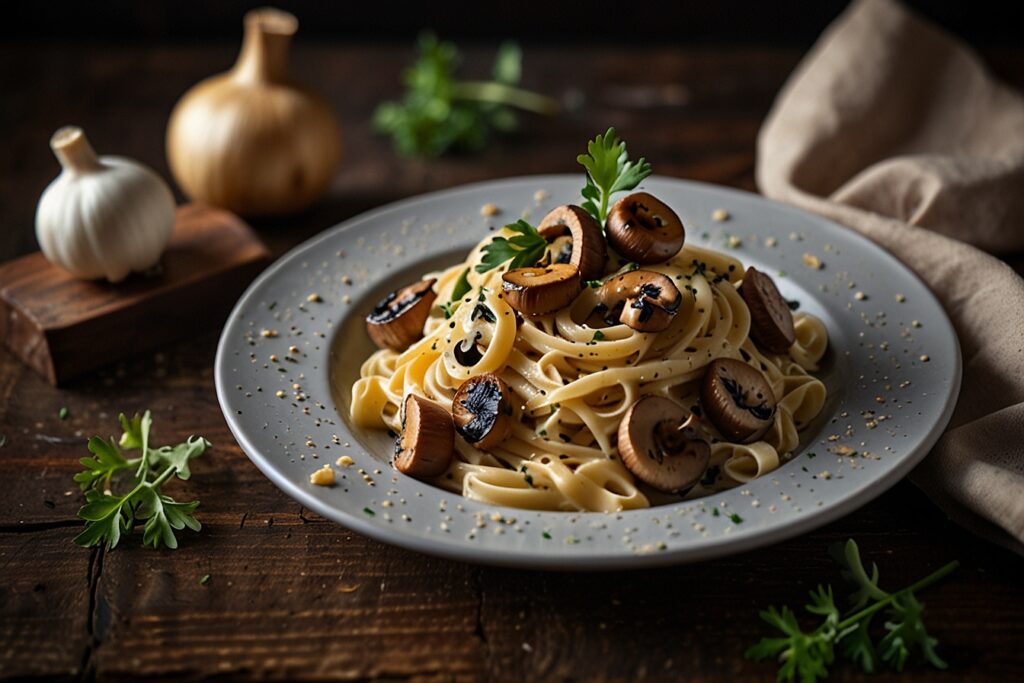
Sun-Dried Tomato and Spinach Alfredo
This recipe came about when I wanted to bridge my love for tomato-based sauces with Alfredo. The result was unexpectedly delicious.
Ingredients:
- 1 cup raw cashews, soaked overnight
- 1/2 cup sun-dried tomatoes in oil, drained
- 4 cups fresh spinach
- 2 cups unsweetened cashew milk
- 4 cloves garlic, minced
- 3 tablespoons nutritional yeast
- 1 tablespoon olive oil
- 2 tablespoons flour
- 1 teaspoon Italian seasoning
- Salt and pepper to taste
- Red pepper flakes (optional)
- 1 pound penne pasta
Instructions:
- Blend soaked cashews, sun-dried tomatoes, and cashew milk until smooth
- Sauté garlic in olive oil until fragrant
- Add flour to create a roux
- Slowly whisk in the cashew mixture
- Add nutritional yeast and seasonings
- Simmer until thickened
- Add spinach and cook until wilted
- Toss with cooked penne
- Top with red pepper flakes if desired
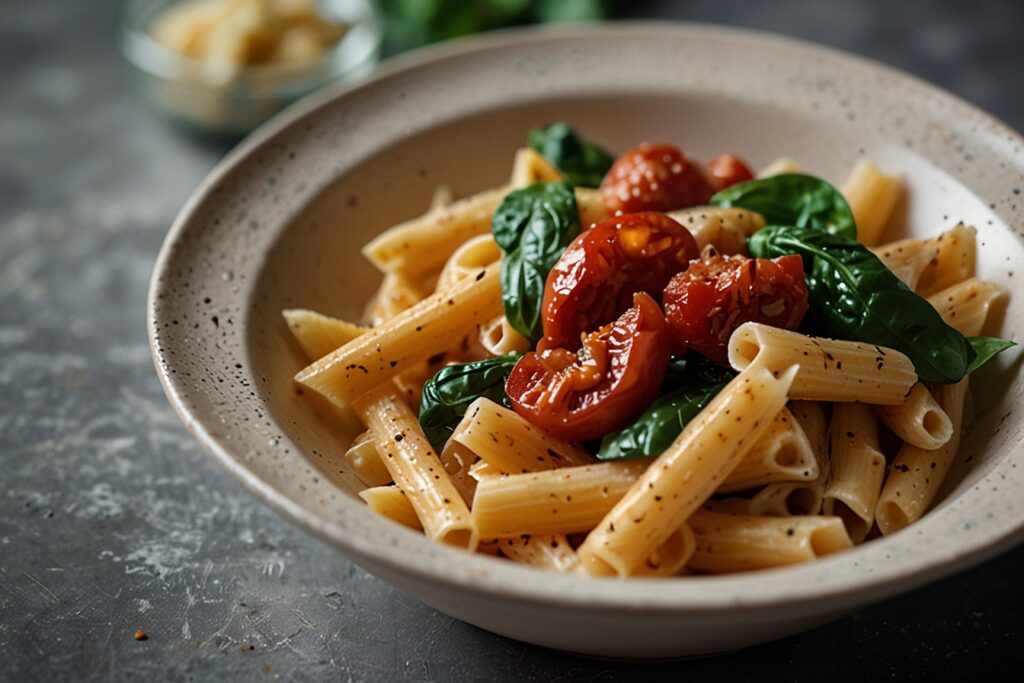
Cauliflower and White Bean Alfredo (Nut-Free Version)
I created this version for a friend with nut allergies, and it turned out to be one of my most requested recipes.
Ingredients:
- 1 large head cauliflower, cut into florets
- 1 can white beans, drained and rinsed
- 4 cloves garlic, minced
- 2 cups unsweetened oat milk
- 3 tablespoons nutritional yeast
- 1 tablespoon olive oil
- 2 tablespoons tapioca starch (or cornstarch)
- 1 teaspoon onion powder
- 1/2 teaspoon white pepper
- Salt to taste
- 1 pound rotini pasta
- Fresh parsley for garnish
Instructions:
- Steam cauliflower until very tender
- Blend cauliflower, white beans, and 1 cup oat milk until smooth
- Sauté garlic in olive oil
- Mix tapioca starch with remaining oat milk
- Add to pan and whisk until thickened
- Stir in cauliflower-bean mixture
- Add nutritional yeast and seasonings
- Simmer for 5-10 minutes
- Toss with cooked rotini
- Garnish with fresh parsley
Each of these recipes serves 4-6 people and can be stored in the refrigerator for up to 3 days. For best results, reheat gently on the stovetop with a splash of plant-based milk to maintain the creamy consistency.
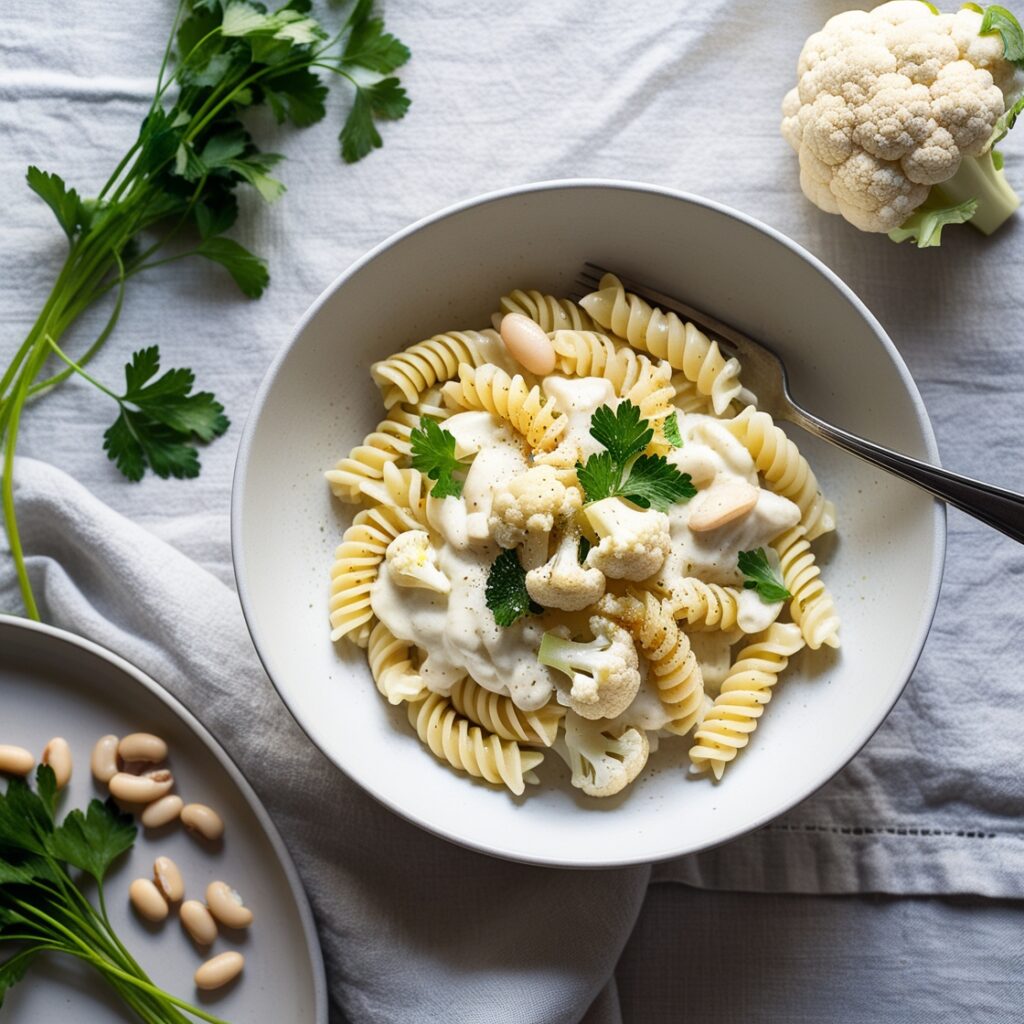
The Impact of Dairy-Free Cooking
Creating this dairy-free Alfredo sauce has done more than just provide an alternative to a classic recipe. It’s opened up new possibilities in the kitchen and shown how inclusive cooking can bring people together. The process has taught me valuable lessons about adaptation, creativity, and the joy of making food that everyone can enjoy. From those with dietary restrictions to curious culinary explorers, this journey proves that with the right ingredients and techniques, you can create something truly special.
For those busy days when making sauce from scratch isn’t feasible, I highly recommend the Primal Kitchen No Dairy Alfredo Sauce. Made with avocado oil, cashew butter, and flavorful spices, this dairy-free sauce delivers authentic taste without compromise. Its smooth texture and rich taste make it an ideal choice for pasta dishes, casseroles, and more.

Primal Kitchen No Dairy Alfredo Sauce
- Alfredo,avocado flavor
- Item weight 16 ounces
- Allergen information: 16 ounces
- Package information: Bottle
My Final Thoughts
This journey of creating a dairy-free Alfredo sauce began with a simple dinner conversation and evolved into a comprehensive exploration of plant-based alternatives. Through multiple recipe iterations, careful ingredient selection, and technique refinement, we’ve created a versatile sauce that rivals its traditional counterpart while accommodating various dietary needs.
Like me, some of you may not venture beyond tomato-based sauces, but your palate deserves the chance to explore and embrace new flavors. We never know what culinary treasures we’re missing unless we step outside our comfort zone and challenge traditional recipes. The key is remaining mindful of our ingredients while being open to creative alternatives. This dairy-free Alfredo sauce proves that dietary restrictions don’t mean compromising on taste or giving up beloved dishes.
Ready to start your own dairy-free cooking adventure? Begin with this Alfredo sauce recipe, and don’t be afraid to adjust it to your taste. Share your creations with friends and family, and join our growing community of mindful cooks who believe in making delicious food accessible to everyone. Tag your dishes with #DairyFreeDelights or #InclusiveCooking, and let’s inspire others to explore the wonderful world of dairy-free cooking together.
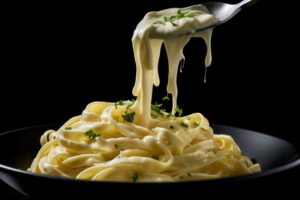
*We may earn a commission for purchases made using our links. Please see our disclosure to learn more.

